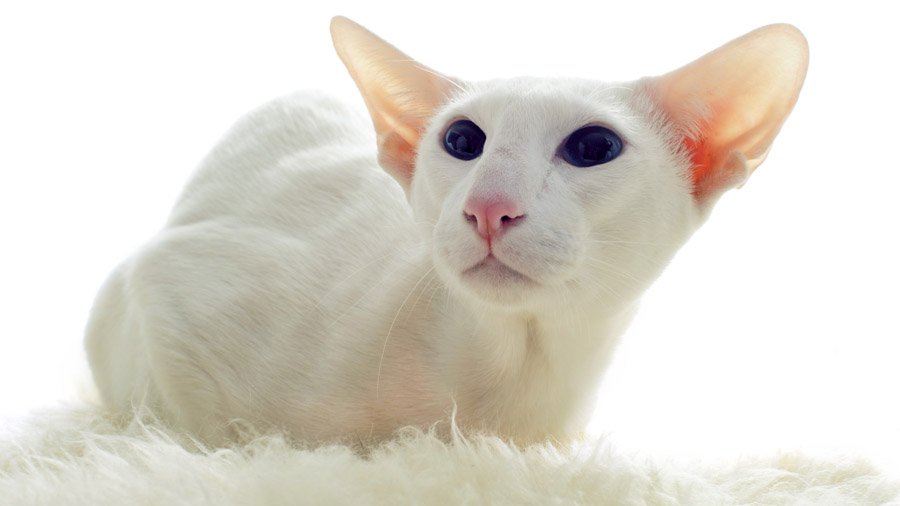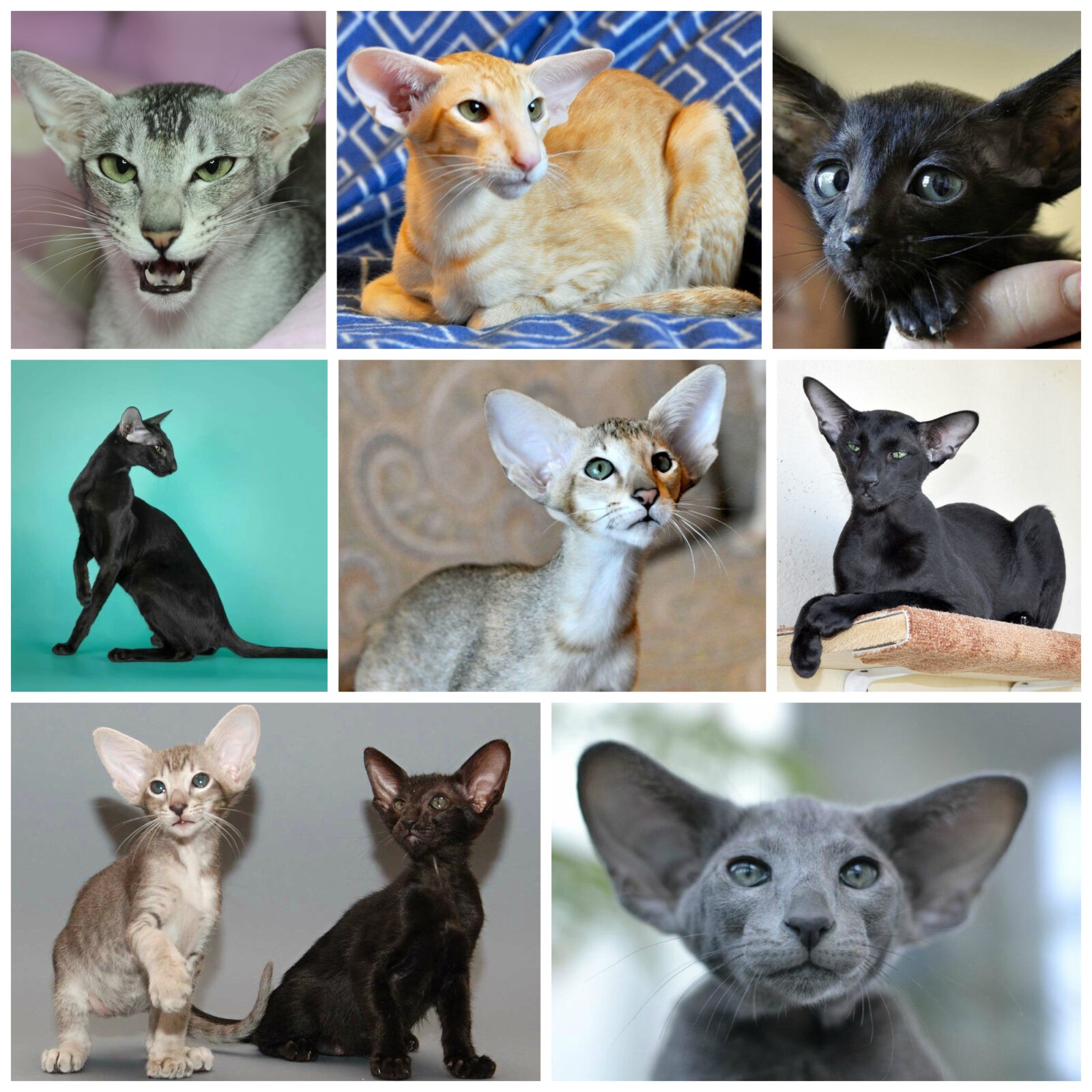Oriental cats are rightly called brothers siamese cats. They have the same roots, and are also very similar to them visually. The only difference between the Oriental cat and the Siamese is the color. Otherwise, they are almost identical.

Brief description of the breed
Pets of this breed have a slender but muscular body with a slightly elongated body and a wedge-shaped head, tapering at the tip of the nose, forming a triangle shape. The shape of the head is emphasized by unusually large ears, wide at the base and pointed at the tips. The eyes of these cats are almond-shaped and medium in size.
Body oriental cat support long, slender legs. And the hind legs are slightly higher than the front. A graceful gait is also provided by small graceful oval paws and a long thin tail.
Because of the limitless color variation, these animals are often referred to as "ornamental plants". The eyes of an oriental cat can be blue, green, or two colors (one blue and the other green). Eye color will depend on the color of the pet.
basic information
| Breed name: | Oriental cat |
| Country of origin: | USA |
| The time of the birth of the breed: | 1957 |
| The weight: | 4 - 7 kg |
|
EMS code:
|
OLH/OSH |
| Life Expectancy: | 16 - 18 years old |
| Kitten price: | 150 – 600 $ |
| Most popular nicknames: | list of nicknames for oriental cats |
Assessment of breed characteristics
|
Adaptability
(A definition that means how easily a cat can adapt to changes in life)
|
🐱🐱🐱🐱🐱 |
|
Shedding level
(Level and frequency of hair loss in the animal)
|
🐱🐱🐱 |
|
Tenderness level
(The level and amount of tenderness and affection that the cat gives in return for attention to itself)
|
🐱🐱🐱🐱🐱 |
|
Social need
(The required number of contacts of a cat with other animals, as well as people)
|
🐱🐱🐱🐱🐱 |
|
Grooming
(The number of bathing, brushing, and the number of professional grooming sessions required for the cat)
|
🐱 |
|
Friendliness in an unfamiliar environment
(Features of the cat's behavior in a society with strangers or in an unfamiliar environment)
|
🐱🐱🐱 |
|
Health issues
(Potential health status of a cat)
|
🐱🐱🐱 |
|
Intelligence
(The ability of a cat to think and solve emerging difficulties)
|
🐱🐱🐱🐱🐱 |
|
Friendliness to children
(A factor that determines how friendly a cat is to children, whether she likes to play with them and tolerate some childish pranks)
|
🐱🐱🐱🐱 |
|
Game activity
(The concept is determined by its very name, and, as a rule, is found in almost all cats)
|
🐱🐱🐱🐱🐱 |
|
Dog friendly
(The cat's tendency to get along with dog)
|
🐱🐱🐱🐱🐱 |
Photo of an oriental cat:

The history of the oriental cat
Oriental cats are most often described as being similar to Siamese cats, but with greatly enlarged ears and original coloration, mostly black and white. The breed was developed by crossing Siamese cats with cats of other breeds. Initially, the purpose of such selection work was to significantly increase the gene pool of Siamese cats, and not at all to breed a new breed. The reason for this was the rapid decline in the Siamese cat population caused by the fighting during World War II.
Within a few years of selection, breeders managed to restore the gene pool of Siamese cats. The bred kittens were completely similar to Siamese cats, except for the color, which was varied. The results of the work of breeders became a prerequisite for the appearance at the official level of a new breed - the oriental cat.
In the seventies of the last century, oriental cats came to the American continent. There, these pets began to be crossed with short-haired and long-haired cats, as a result of which there are now two varieties of oriental cats. As for the color, it is still very diverse, the breeders say that today the color of the pet's coat can vary in three hundred colors.
Until today, between various breeder associations cats there is a dispute about the recognition of oriental cats as pets of a separate breed. Some are inclined to believe that the oriental cat is a kind of Siamese, while others defend the opinion regarding the independence of this breed.
The nature of the oriental cat
Oriental cats differ not only in color, but also in the individuality of their character. If these cats could talk, then it would be safe to say that they are very talkative. Your pet will definitely let you know by voice that he wants something or is dissatisfied with something. With its rather loud voice, the pet will always attract the attention of the owner and family members. Oriental cats also love to bask near their owner, quite often they sleep with him in the same bed, burrowing deep under the covers.
An oriental cat is suitable for those people who like to talk to someone and absolutely not suitable for those who do not like the meow of cats. This pet will become a true and faithful friend. At the same time, you must be completely sure that you have enough time to care for, educate and just communicate with a cat of this breed. The fact is that oriental cats are incredibly sociable, so it is difficult to endure separation and loneliness. Pets of this breed are definitely not suitable for owners who spend most of their time outside the home, but, for example, at work. True, busy people have a way out in case they are not able to pay much attention to the animal, and are forced to leave them during the day. In order for an oriental cat not to feel abandoned and lonely, you can have two pets that will entertain each other during the absence of family members.
Oriental cats are incredibly smart and agile. They love various active games, as well as tasks in which you need to show intelligence and ingenuity. Be prepared for the fact that you will have to systematically provide your pet with appropriate exercises and games. It is useful to stock up on various toys in advance, you can also purchase a special tree for climbing or make it yourself.
Never leave an Oriental cat without toys or other interesting activities. In this case, the pet will be bored, and if at the same time there is still one at home, then he will be completely homesick. In addition, pet boredom can negatively affect your home. The cat is more likely to gnaw on furniture, toilet paper, decor items, etc.
Oriental cats are loyal, gentle pets that require a lot of attention. You should not get a pet if you are not sure that you can devote a lot of time to it.
Maintenance and care
The short and fine coat of Oriental cats is very easy to care for. It will be enough to comb the pet about once every two weeks with a special stainless steel brush or a brush with soft bristles. After combing, it is recommended to wipe the pet's coat with a cloth. This will give the coat smoothness and shine.
Mandatory weekly procedures include oral hygiene of the animal. Brushing your teeth will help prevent a number of dental diseases. In addition, every week it is necessary to wipe the corners of the cat's eyes with a cloth (a separate cloth for each eye). It is worth remembering the need for constant monitoring of the condition of the ears. Make sure that your pet does not have inflammation, irritation, or infection in the ears. Treat the ears with a special solution prescribed by the veterinarian. The auricles can also be wiped with a mixture of vinegar and plain drinking water in a 1:1 ratio. Avoid using a cotton swab, which can harm the animal's ear canal.
To prevent the occurrence of infectious diseases, it is necessary to keep the cat tray in perfect cleanliness. Very often, cats that walk uncontrollably on the street have parasites (fleas, worms). Therefore, it is best to protect the contact of an oriental cat with unfamiliar animals.
Health and disease
Both varieties of oriental cats have various diseases characteristic of them, which are mostly genetic in nature. It is worth noting that Siamese and Oriental cats have the same basic health problems.
Amyloidosis is a disease during which a large amount of a special protein, amyloid, is deposited in the internal organs, mainly in the liver. Characteristic for representatives of this breed are also diseases such as bronchial asthma, congenital heart defects, for example, aortic stenosis.
Oriental cats are often diagnosed with gastrointestinal problems such as hyperesthesia. Neurological diseases are also quite common, often leading to hair loss. Against the background of neurological problems, some representatives of this breed have problems with the eyes. Retinal atrophy caused by a genetic disorder can also occur.
Some interesting facts
- Oriental cats are direct relatives of Siamese cats, as they arose by crossing Siamese breeds with other cats.
- Almost the only difference between the Oriental cat and the Siamese is the color.
- Oriental cats are extremely sociable, they require a lot of attention, so they are not suitable for people who spend most of their time at work.
- Pets This breed is active and adore various sports games and exercises.
- The Oriental cat is one of the easiest pets to take care of.
- Cats of this breed are prone to various diseases of a genetic nature. That is why it is necessary to purchase pets exclusively from trusted breeders.
Nurseries and breeders
We borrowed material from the wonderful site of our partners DOGCATFAN.COM about cats and dogs, the author dogcatfan
